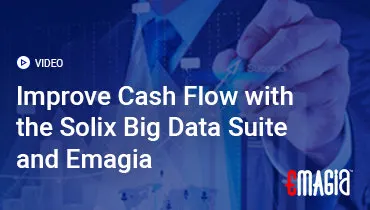Every finance department has a hidden vortex of inefficiency: the AR and AP email inboxes. It’s where invoices, remittances, payment instructions, and a dozen other critical documents land, waiting to be manually sorted, opened, and processed. This seemingly simple task is a constant drain on time and resources, a silent killer of productivity. But what if you could teach a system to do it for you, with perfect accuracy and at superhuman speed? This is not a futuristic fantasy; it’s a reality being implemented in businesses today. Our deep dive into an AR and AP email inboxes data extract example will show you how to move from a manual, error-prone process to a streamlined, automated workflow that transforms your accounts receivable and accounts payable operations for good.
Before we even get to the step-by-step examples, it’s crucial to understand the fundamental problems that make this kind of automation not just a nice-to-have, but a must-have for any modern business. We’ll explore the hidden costs of manual data entry, the risks of human error, and the bottlenecks that prevent your finance team from focusing on strategic, high-value tasks. This guide is your blueprint for creating a more efficient, accurate, and scalable financial operation. Let’s get started.
The Dire Consequences of Manual AR & AP Data Entry
The time-consuming nature of manual data entry is a well-known problem, but its true impact extends far beyond simple labor costs. The ripple effect of relying on humans to sort through and process every single email and attachment can lead to significant financial and operational damage. From missed payment deadlines to inaccurate financial reporting, the consequences can be severe. It is a slow and painful process that breeds mistakes and inefficiency. Let’s examine some of the most critical challenges.
Human Error and Inaccurate Financial Records
The biggest and most insidious problem with manual data entry is the inevitability of human error. Typos, transposed numbers, and misinterpretations of data are not a matter of if, but when. A single mistake on an invoice number or payment amount can lead to a cascade of problems, from delayed payments and strained vendor relationships to incorrect financial statements and compliance issues. The cost of correcting these errors alone can be substantial, often requiring multiple team members to spend valuable time on a problem that should have never existed.
In a world where speed and accuracy are paramount, a reliance on manual processing puts your business at a significant disadvantage. The best-case scenario is a minor correction; the worst-case is a complete breakdown in your financial reconciliation process. Automation is the only surefire way to eliminate these risks at the source.
Lost Opportunities and Stagnated Workflows
For accounts payable, a slow manual process means missing out on early payment discounts, which can add up to significant savings over time. For accounts receivable, it means a slower cash conversion cycle, leaving money tied up and negatively impacting your company’s working capital. A manual workflow creates a bottleneck, turning your team into a processing factory rather than a strategic financial asset. Employees are stuck performing repetitive, low-value tasks instead of analyzing data, managing cash flow, and building stronger relationships with suppliers and customers.
This is where the true cost of manual data entry becomes apparent. It’s not just about the hours spent; it’s about the opportunities missed. Automation frees your team to become strategic partners in your business’s growth rather than clerical workers fighting a never-ending battle against a mountain of paperwork.
Scalability Issues and the Inefficient Use of Resources
As your business grows, so does the volume of transactions, invoices, and payment data. A manual system simply cannot scale. Adding more employees to handle the increased workload is not a sustainable or cost-effective solution. It is an inefficient use of resources and introduces even more opportunities for error. The system breaks under its own weight, causing delays and frustration. Automation, by its very nature, is designed for scalability. A well-configured system can handle an exponential increase in volume without a corresponding increase in labor, allowing your finance operations to grow seamlessly with the rest of your business.
Unveiling the Power of Automated Data Extraction from Financial Emails
So, what does this automated utopia look like? It’s a seamless process where emails are received, data is intelligently extracted, and information is validated and routed to the correct system with zero human intervention. This is where AI-driven technologies come into play, performing tasks that were once considered impossible without a human touch. Let’s break down the core components of this powerful solution.
Leveraging Intelligent Document Processing (IDP) and OCR
At the heart of modern data extraction from email attachments is Intelligent Document Processing (IDP). Unlike traditional OCR, which simply converts images to text, IDP uses a combination of technologies to understand the context of a document. It can recognize an invoice number regardless of where it appears on a page, identify line items even if the table format changes, and extract the correct due date even if it is presented in a non-standard way. This technology is the engine that drives a robust and reliable automation solution.
Natural Language Processing (NLP) for Email Content Analysis
But what about the email body itself? This is where Natural Language Processing (NLP) takes over. An NLP-powered system can read the text of an email to determine its intent. Is it a request for an invoice status update? Is it a payment reminder? Is it an inquiry about a discrepancy? By understanding the content, the system can automatically classify the email, route it to the appropriate team, or even generate a template-based response. This eliminates the need for a human to read, sort, and forward every single message, saving countless hours and ensuring a faster response time.
A Detailed AR and AP Email Inboxes Data Extract Example Workflow
To truly understand the power of this technology, let’s walk through a complete, step-by-step example. This workflow can be adapted for both accounts payable and accounts receivable, demonstrating the versatility of the solution. Imagine a system that automatically handles invoices as they arrive in your AP inbox. This is the real-world application of an AR and AP email inboxes data extract example that transforms business operations.
Step 1: The Automated Intake and Classification of Emails
The process begins the moment a new email arrives in the designated AP inbox. The automation platform acts as the first line of defense, scanning the email and its attachments. Using a combination of keywords, sender recognition, and NLP, the system automatically classifies the email. Is it a new invoice? A payment reminder? A vendor inquiry? The system tags it accordingly and routes it to the correct virtual folder for processing. This single step eliminates the need for a human to manually triage the inbox, ensuring no email is ever missed or misfiled.
Step 2: Intelligent Data Extraction from Attachments
Once an email is classified as a new invoice, the system’s IDP engine takes over. It opens the attached PDF, JPEG, or other document and begins to intelligently extract key data fields. This includes:
- Invoice number
- Invoice date
- Due date
- Supplier name
- Total amount due
- Line item details (if needed)
The beauty of an intelligent system is its ability to find this information even if the invoice format changes from one supplier to the next. The system learns and adapts, achieving a high degree of accuracy over time. It can even extract data from handwritten notes or scanned documents with remarkable precision.
Step 3: Automated Validation and Exception Handling
After the data has been extracted, the system doesn’t just blindly trust the results. It performs a series of automated validation checks. This can include:
- Verifying the supplier’s name and details against your master vendor list.
- Checking for duplicate invoices based on the invoice number, date, and amount.
- Matching the invoice with a corresponding purchase order (PO) in your system.
- Validating the total amount and ensuring the math is correct.
If any of these checks fail, the system flags it as an “exception” and routes it to a human for review. This is where automation doesn’t replace humans, but rather empowers them to focus on the truly complex problems that require judgment and critical thinking. The system handles the simple, repetitive tasks, and the human handles the exceptions.
Step 4: Seamless Integration and Posting to Your ERP
For all valid invoices, the final step is a seamless integration with your existing Enterprise Resource Planning (ERP) or accounting software. The system automatically creates a new entry, populating all the extracted data fields. This eliminates the need for manual data entry into your financial system, ensuring that your records are always up-to-date and accurate. The entire process, from the email arriving in the inbox to the invoice being posted in your ERP, can take just a few minutes, a drastic reduction from the hours or even days it would take a human to complete manually.
Key Benefits of Automating AR and AP Email Data Extraction
The benefits of implementing a solution like the one described above are numerous and far-reaching. They touch every aspect of your finance department and contribute to the overall health and agility of your business. This is why a strategic approach to an AR and AP email inboxes data extract example is more than just an IT project—it’s a business transformation.
Accelerated Processing Time and Improved Cash Flow
The most immediate and tangible benefit is the dramatic reduction in processing time. Invoices that once sat in an inbox for days can be processed and posted in minutes. For AR, this means faster collections and a healthier cash flow. For AP, it means the ability to capture early payment discounts and build stronger relationships with suppliers. The speed of automation directly impacts your business’s financial liquidity and profitability.
Enhanced Accuracy and Reduced Risk of Fraud
By eliminating manual data entry, you effectively eliminate the potential for human error. The system’s validation checks and automated matching processes provide an added layer of security and accuracy. Furthermore, these systems are excellent at flagging suspicious activity or potential fraud, such as duplicate invoices or changes in vendor banking information. This enhanced accuracy and fraud detection capability safeguards your business from financial risk.
Better Visibility and Comprehensive Audit Trails
An automated system provides a complete, digital audit trail of every transaction. You can track an invoice from the moment it arrived in your inbox to the moment it was paid, with every step, check, and approval recorded. This level of visibility makes it easier to respond to vendor inquiries, resolve disputes, and prepare for audits. It provides a single source of truth for all your financial documents, eliminating data silos and creating a more transparent and controlled environment.
Empowering Your Finance Team to Focus on Strategic Tasks
By taking over the repetitive, low-value work, automation frees your finance team to do what they do best: analyze data, forecast trends, and provide strategic insights. Instead of spending their days copying and pasting data, they can focus on optimizing cash flow, managing supplier relationships, and contributing to the overall financial health of the business. This shift transforms the finance department from a cost center into a strategic value driver.
Advanced AI-Powered Invoice Automation and Reconciliation
Beyond the simple extraction of data, advanced AI solutions can take automation to the next level. Imagine a system that not only extracts data but also automatically codes the invoice to the correct general ledger account based on historical data and machine learning. This is where true intelligence meets automation. The system can learn from past transactions to make predictions about future ones, further reducing the need for human intervention and increasing the efficiency of the entire process.
Navigating Implementation and Choosing the Right Solution
Implementing an automated data extraction solution is a strategic project that requires careful planning and execution. The success of the project hinges on a number of key factors, from gaining internal buy-in to choosing the right technology partner. Here is a brief guide to help you navigate this process.
Assessing Your Current AR and AP Email Workflows
Before you even begin looking at software, you need a clear and honest understanding of your current process. Map out the journey of an invoice or a remittance from the moment it arrives in your inbox to the moment it is posted in your financial system. Identify the bottlenecks, the pain points, and the areas where errors are most likely to occur. This assessment will be your benchmark for measuring the success of your new automation solution.
Identifying Key Features of the Right Software
Not all automation solutions are created equal. When evaluating software, look for a solution that offers a comprehensive set of features, including:
- Intelligent data extraction from a variety of document types.
- Seamless integration with your existing ERP or accounting system.
- Automated validation and exception handling.
- Comprehensive reporting and an auditable trail.
- A user-friendly interface that is easy to configure and use.
The right platform will be a true partner in your digital transformation, not just another piece of software to manage. It should be scalable, secure, and adaptable to your specific business needs.
How Emagia Helps You Master AR & AP Automation
Emagia is a leader in modern finance automation, offering an advanced platform that goes beyond simple data extraction. Their intelligent automation suite is designed to tackle the most complex challenges in accounts receivable and accounts payable, providing a complete, end-to-end solution. Emagia’s platform leverages cutting-edge AI and machine learning to offer a full range of capabilities, from the initial intake and classification of financial documents to predictive analytics and cash flow forecasting. Their technology ensures a high level of accuracy and efficiency, enabling businesses to achieve a truly touchless finance operation. By providing a single, unified platform for all your AR and AP needs, Emagia simplifies your workflow, accelerates your cash conversion cycle, and empowers your finance team to focus on strategic growth.
Their solution is not just about automating a single task, but about orchestrating a complete digital transformation of your financial operations, providing unparalleled visibility, control, and performance.
Frequently Asked Questions
What is the difference between OCR and Intelligent Document Processing (IDP)?
While OCR (Optical Character Recognition) converts images to text, IDP (Intelligent Document Processing) goes a step further by using AI and machine learning to understand the context of the data. IDP can extract specific data fields (like an invoice number or a due date) regardless of where they are on the document, making it far more powerful for financial document automation.
Can I automate data extraction from both AR and AP emails?
Yes, the core principles of data extraction and workflow automation apply to both accounts receivable and accounts payable. The primary difference is the type of document you are processing (invoices for AP, remittance advices for AR) and the destination of the extracted data.
How do these systems handle invoices with multiple attachments or password-protected files?
Modern automation solutions are designed to handle complex scenarios like these. They can process multiple attachments from a single email and, in some cases, can even handle password-protected files by integrating with your internal systems or by flagging them for manual human intervention.
What is the typical accuracy rate for automated data extraction?
The accuracy rate of an automated system can vary based on the quality of the documents and the sophistication of the technology. However, advanced AI-powered systems can achieve accuracy rates of 95% or higher, significantly reducing the errors associated with manual data entry.
Is it possible to integrate these solutions with my existing ERP system?
Yes, one of the most critical features of a good automation solution is its ability to seamlessly integrate with your existing ERP or accounting software. Most modern platforms have pre-built connectors for popular systems like SAP, Oracle, NetSuite, and others, or can integrate via a custom API.



